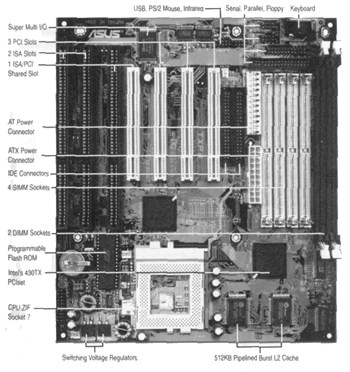Hardware
The following sections discuss the hardware
that is commonly found in most computer systems.
that is commonly found in most computer systems.
Inside the box
The box contains the electronic parts of the computer. These are usually found attached to the computerís motherboard.One of the most important components of a computer is the power supply.
The power supply is located securely inside the box. It takes the normal electricity supply (240V) and converts it to a voltage level that the computer can use internally.
The box usually contains a hard disk, floppy disk drive and/or a CD-ROM drive. These are usually attached to the motherboard via cables.

Processors
The processor or CPU (Central Processing Unit) plugs into the computerís motherboard. It is usually what people refer to when they talk about the computerís chip.
The processor controls the operation of the computer. It does all arithmetic operations, collects data from the input devices, sends data to output devices, records what programs you are running and what you are doing in them etc.
The main criteria for a processor is speed. The faster the processor, the more work it can do in a set time period (usually one second). The speed of a processor is measured in MegaHertz (MHz). This is a measure of how many things a computer can do in one second. The higher the megahertz, the more things a computer can do in a second.
Intel Inside
Intel is the name of a company that manufactures computer chips. One of these chips is a CPU. The CPU chips made by Intel are called Pentiums. These come in a variety of speeds. The sign "Intel Inside" on the front of a computer means that the CPU in the computer was made by Intel.Internal Memory
Internal memory is plugged into the computerís motherboard. It consists of RAM and ROM.ROM stands for read only memory. Anything stored as ROM can not be altered. ROM is usually set by the manufacturer of the computer to contain the programs necessary to start the computer. Turning off the computer does not erase the contents of ROM.
RAM stands for random access memory. It temporarily stores data and information and programs while you are working with them. Turning off the computer erases the RAM contents.
As the computer runs a program, it stores the program in RAM. If the program is bigger than the RAM (as most are) it is stored in the RAM in sections. The first section is put into RAM and run through, then the second section is read into RAM and run through, and so on. The more RAM a computer has, the bigger the section of the program it can store at one time. This means that the computer has to do less copying of sections.
For example, you need 32M of RAM to run Windows 95 smoothly.
Virtual memory is a way of making the computer operate as though it has more RAM than it actually does.
Motherboards
A motherboard (called the main board in Apple Macintoshes) is a circuit board that has slots on it where components can be slotted into. Usually, the CPU and internal RAM and ROM are slotted onto the motherboard.The hard disk, floppy disk drive, and printer all connect directly to the motherboard via ribbon cables. When you plug your printer into the printer port at the back of the computer, it can connect to a cable that is connected to the motherboard. The keyboard and monitor connect directly to the motherboard.

Towers
A Tower is a vertical computer box. More precisely it is an empty case that can be filled with components to make a computer. The power supply is the essential item, and most towers also contain a motherboard, internal and external memory.
Towers come in different sizes. You can have a small, midi or full tower.